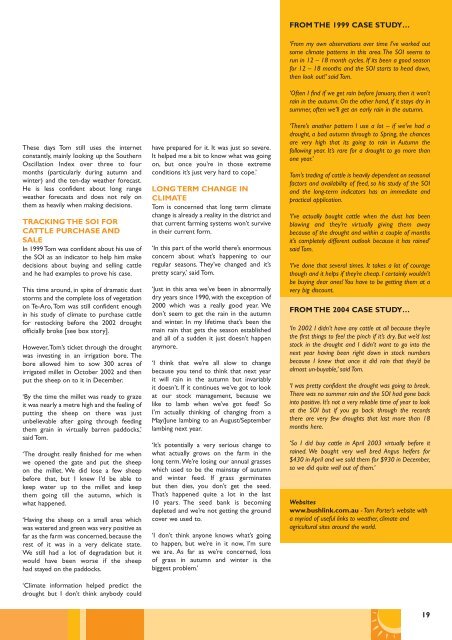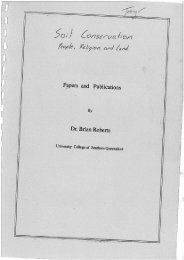Masters of the Climate: Innovative farmers ... - South West NRM
Masters of the Climate: Innovative farmers ... - South West NRM
Masters of the Climate: Innovative farmers ... - South West NRM
You also want an ePaper? Increase the reach of your titles
YUMPU automatically turns print PDFs into web optimized ePapers that Google loves.
FROM THE 1999 CASE STUDY…<br />
These days Tom still uses <strong>the</strong> internet<br />
constantly, mainly looking up <strong>the</strong> Sou<strong>the</strong>rn<br />
Oscillation Index over three to four<br />
months (particularly during autumn and<br />
winter) and <strong>the</strong> ten-day wea<strong>the</strong>r forecast.<br />
He is less confident about long range<br />
wea<strong>the</strong>r forecasts and does not rely on<br />
<strong>the</strong>m as heavily when making decisions.<br />
TRACKING THE SOI FOR<br />
CATTLE PURCHASE AND<br />
SALE<br />
In 1999 Tom was confident about his use <strong>of</strong><br />
<strong>the</strong> SOI as an indicator to help him make<br />
decisions about buying and selling cattle<br />
and he had examples to prove his case.<br />
This time around, in spite <strong>of</strong> dramatic dust<br />
storms and <strong>the</strong> complete loss <strong>of</strong> vegetation<br />
on Te-Aro, Tom was still confident enough<br />
in his study <strong>of</strong> climate to purchase cattle<br />
for restocking before <strong>the</strong> 2002 drought<br />
<strong>of</strong>ficially broke [see box story].<br />
However,Tom’s ticket through <strong>the</strong> drought<br />
was investing in an irrigation bore. The<br />
bore allowed him to sow 300 acres <strong>of</strong><br />
irrigated millet in October 2002 and <strong>the</strong>n<br />
put <strong>the</strong> sheep on to it in December.<br />
‘By <strong>the</strong> time <strong>the</strong> millet was ready to graze<br />
it was nearly a metre high and <strong>the</strong> feeling <strong>of</strong><br />
putting <strong>the</strong> sheep on <strong>the</strong>re was just<br />
unbelievable after going through feeding<br />
<strong>the</strong>m grain in virtually barren paddocks,’<br />
said Tom.<br />
‘The drought really finished for me when<br />
we opened <strong>the</strong> gate and put <strong>the</strong> sheep<br />
on <strong>the</strong> millet. We did lose a few sheep<br />
before that, but I knew I’d be able to<br />
keep water up to <strong>the</strong> millet and keep<br />
<strong>the</strong>m going till <strong>the</strong> autumn, which is<br />
what happened.<br />
‘Having <strong>the</strong> sheep on a small area which<br />
was watered and green was very positive as<br />
far as <strong>the</strong> farm was concerned, because <strong>the</strong><br />
rest <strong>of</strong> it was in a very delicate state.<br />
We still had a lot <strong>of</strong> degradation but it<br />
would have been worse if <strong>the</strong> sheep<br />
had stayed on <strong>the</strong> paddocks.<br />
‘<strong>Climate</strong> information helped predict <strong>the</strong><br />
drought but I don’t think anybody could<br />
have prepared for it. It was just so severe.<br />
It helped me a bit to know what was going<br />
on, but once you’re in those extreme<br />
conditions it’s just very hard to cope.’<br />
LONG TERM CHANGE IN<br />
CLIMATE<br />
Tom is concerned that long term climate<br />
change is already a reality in <strong>the</strong> district and<br />
that current farming systems won’t survive<br />
in <strong>the</strong>ir current form.<br />
‘In this part <strong>of</strong> <strong>the</strong> world <strong>the</strong>re’s enormous<br />
concern about what’s happening to our<br />
regular seasons. They’ve changed and it’s<br />
pretty scary,’ said Tom.<br />
‘Just in this area we’ve been in abnormally<br />
dry years since 1990, with <strong>the</strong> exception <strong>of</strong><br />
2000 which was a really good year. We<br />
don’t seem to get <strong>the</strong> rain in <strong>the</strong> autumn<br />
and winter. In my lifetime that’s been <strong>the</strong><br />
main rain that gets <strong>the</strong> season established<br />
and all <strong>of</strong> a sudden it just doesn’t happen<br />
anymore.<br />
‘I think that we’re all slow to change<br />
because you tend to think that next year<br />
it will rain in <strong>the</strong> autumn but invariably<br />
it doesn’t. If it continues we’ve got to look<br />
at our stock management, because we<br />
like to lamb when we’ve got feed! So<br />
I’m actually thinking <strong>of</strong> changing from a<br />
May/June lambing to an August/September<br />
lambing next year.<br />
‘It’s potentially a very serious change to<br />
what actually grows on <strong>the</strong> farm in <strong>the</strong><br />
long term. We’re losing our annual grasses<br />
which used to be <strong>the</strong> mainstay <strong>of</strong> autumn<br />
and winter feed. If grass germinates<br />
but <strong>the</strong>n dies, you don’t get <strong>the</strong> seed.<br />
That’s happened quite a lot in <strong>the</strong> last<br />
10 years. The seed bank is becoming<br />
depleted and we’re not getting <strong>the</strong> ground<br />
cover we used to.<br />
‘I don’t think anyone knows what’s going<br />
to happen, but we’re in it now, I’m sure<br />
we are. As far as we’re concerned, loss<br />
<strong>of</strong> grass in autumn and winter is <strong>the</strong><br />
biggest problem.’<br />
‘From my own observations over time I’ve worked out<br />
some climate patterns in this area. The SOI seems to<br />
run in 12 – 18 month cycles. If its been a good season<br />
for 12 – 18 months and <strong>the</strong> SOI starts to head down,<br />
<strong>the</strong>n look out!’ said Tom.<br />
‘Often I find if we get rain before January, <strong>the</strong>n it won’t<br />
rain in <strong>the</strong> autumn. On <strong>the</strong> o<strong>the</strong>r hand, if it stays dry in<br />
summer, <strong>of</strong>ten we’ll get an early rain in <strong>the</strong> autumn.<br />
‘There’s ano<strong>the</strong>r pattern I use a lot – if we’ve had a<br />
drought, a bad autumn through to Spring, <strong>the</strong> chances<br />
are very high that its going to rain in Autumn <strong>the</strong><br />
following year. It’s rare for a drought to go more than<br />
one year.’<br />
Tom’s trading <strong>of</strong> cattle is heavily dependent on seasonal<br />
factors and availability <strong>of</strong> feed, so his study <strong>of</strong> <strong>the</strong> SOI<br />
and <strong>the</strong> long-term indicators has an immediate and<br />
practical application.<br />
‘I’ve actually bought cattle when <strong>the</strong> dust has been<br />
blowing and <strong>the</strong>y’re virtually giving <strong>the</strong>m away<br />
because <strong>of</strong> <strong>the</strong> drought and within a couple <strong>of</strong> months<br />
it’s completely different outlook because it has rained’<br />
said Tom.<br />
‘I’ve done that several times. It takes a lot <strong>of</strong> courage<br />
though and it helps if <strong>the</strong>y’re cheap. I certainly wouldn’t<br />
be buying dear ones! You have to be getting <strong>the</strong>m at a<br />
very big discount.<br />
FROM THE 2004 CASE STUDY…<br />
‘In 2002 I didn’t have any cattle at all because <strong>the</strong>y’re<br />
<strong>the</strong> first things to feel <strong>the</strong> pinch if it’s dry. But we’d lost<br />
stock in <strong>the</strong> drought and I didn’t want to go into <strong>the</strong><br />
next year having been right down in stock numbers<br />
because I knew that once it did rain that <strong>the</strong>y’d be<br />
almost un-buyable,’ said Tom.<br />
‘I was pretty confident <strong>the</strong> drought was going to break.<br />
There was no summer rain and <strong>the</strong> SOI had gone back<br />
into positive. It’s not a very reliable time <strong>of</strong> year to look<br />
at <strong>the</strong> SOI but if you go back through <strong>the</strong> records<br />
<strong>the</strong>re are very few droughts that last more than 18<br />
months here.<br />
‘So I did buy cattle in April 2003 virtually before it<br />
rained. We bought very well bred Angus heifers for<br />
$430 in April and we sold <strong>the</strong>m for $930 in December,<br />
so we did quite well out <strong>of</strong> <strong>the</strong>m.’<br />
Websites<br />
www.bushlink.com.au - Tom Porter’s website with<br />
a myriad <strong>of</strong> useful links to wea<strong>the</strong>r, climate and<br />
agricultural sites around <strong>the</strong> world.<br />
19
















